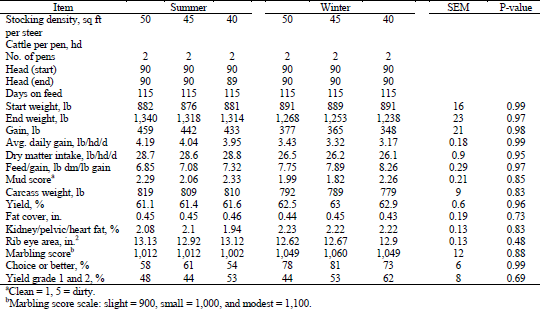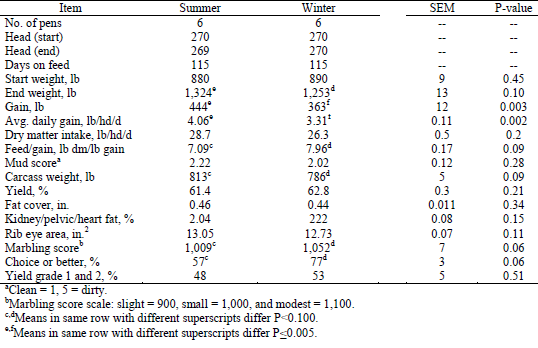



Stocking Density Effects on Steer Performance
The objective of this study, by Iowa State University, was to determine the effects of increased stocking density on performance and carcase characteristics of steers fed in bedded hoop and bedded open front facilities. It determined that market cattle can probably be stocked at 35-37 square foot per steer in hoop barns, with no affect on carcase characteristics.Summary and Implications
Use of bedded hoop barns for feeding cattle has grown in part due to increased regulations regarding open feedlot runoff. In 2010, ISU estimated almost 700 hoop barns in Iowa used for beef cattle and more than 80% were used for cattle feeding. Work in Iowa also has documented that cattle confined in a bedded hoop barn perform similarly to cattle fed in an open feedlot with shelter. The work was done with a stocking density of 50 sq ft per steer in the bedded hoop barn. A hoop barn is a more expensive facility system compared with open lot configurations. Fixed costs per steer (facilities) are partially determined by stocking density. The objective of this study was to determine the effects of increased stocking density on performance and carcass characteristics of steers fed in bedded hoop and bedded open front facilities.
The trials were conducted in 2008 to 2011 at the ISU Armstrong Research Farm, Lewis, IA. The hoop barn was stocked with 40, 45 and 50 head per pen resulting in 50, 45 and 40 sq ft per steer, respectively. There was one stocking density per housing type per trial. The diet fed was 45.0% dry corn, 14.8% ground hay, 36.8% modified distillers grains and 3.4% supplement on an as-fed basis. The total diet was approximately 69% dry matter.
Cattle growth rate (ADG), feed intake (DMI), feed efficiency (F/G) and mean mud score did not differ based on stocking density (P>0.05). However, the cattle given more square feet numerically had greater feed intake and were more efficient (about 4-5%) than the more densely stocked cattle. This study may not have had enough replications to detect statistically significant differences. Also the mean carcass characteristics (fat cover, rib eye area, marbling score, quality grade and yield grade) did not differ by stocking density (P>0.05).
When comparing seasons only, steers fed in summer tended to have heavier market liveweight, heavier carcass weight, required less feed per liveweight and less marbling compared with steers fed in winter (P?0.10). Also, the summer-fed steers grew faster and gained more liveweight than the winter-fed steers (P<0.005).
These results suggest that this study may not have reached the maximum stocking density for feeding beef cattle in a bedded hoop barn. In other words, market cattle can probably be stocked at less square footage per steer than the 40 sq ft per steer used in this study. Observations of farmers with hoop barns suggest that 37 or 35 sq ft per steer may be feasible.
Several factors may affect stocking density including genetics or frame size of the cattle and may interact with season. Also, it should be noted that as the density of cattle increases, more management is required, i.e., more bedding, more bunk space, more waterer space and observing individual cattle for health issues becomes more difficult.
Introduction
Work in Iowa has shown that cattle confined in a bedded hoop barn perform similarly to cattle fed in an open feedlot with shelter. Cattle fed in the hoop barn carried less mud than cattle in the feedlot. The work was done with a stocking density of 50 sq ft per steer in the bedded hoop barn. The hoop barn is a more expensive facility system compared with open lot configurations. Fixed costs (facilities) are partially determined by stocking density. The more steers in a given facility, the lower per steer cost of the facility. Therefore, the objective of this study was to determine the effects of increased stocking density on performance and carcass characteristics of steers fed in bedded hoop and bedded open front facilities.
Materials and Methods
Four trials were conducted in 2008 to 2011 at the ISU Armstrong Research Farm, Lewis, IA. The hoop barn (50 x 120 ft) had three pens with fenceline bunk and automatic waterers. The hoop barn is described in Hoop Barns for Beef Cattle (MidWest Plan Service AED-50) or a prior Animal Industry Report (ASL-R2000). The hoop barn was stocked with 40, 45 and 50 head per pen resulting in 50, 45 and 40 sq ft per steer, respectively. Although our earlier work did not document any pen effects, we wanted to minimize and balance any effects of the pens. The three pens are—a north end pen, a middle pen, and a south end pen. Total bunk space was the same for each pen.
To minimize pen effects, the pens of cattle were rotated to a different pen within the hoop barn at each weigh day (approximately every 28d). There was one stocking density per housing type per trial. There were two summer trials (May to Aug/Sept) and two winter trials (Nov/Dec to March). Cattle were fed until the entire group was visually assessed to be >50% Choice grade. All cattle on a trial were taken off of the trial and marketed at the same time.
The pens were bedded with cornstalks and cleaned as needed. If any pen needed bedding, all pens in both facilities were bedded. Cattle were fed once daily. The diet fed was 45.0% dry corn, 14.8% ground hay, 36.8% modified distillers grains and 3.4% supplement on a dry matter basis. The total diet was approximately 69% dry matter. Performance and carcass data were collected. Means by housing type by stocking density are presented. The experimental unit was a pen of steers.
Results and Discussion
Cattle were fed for an average of 115 days from 885 to 1276-1304 lb liveweight. Means for cattle performance measures and carcass characteristics by stocking density across all trials are shown in Table 1. Cattle growth rate (ADG), feed intake (DMI), feed efficiency (F/G) and mean mud score did not differ based on stocking density (P>0.05). However, the cattle given more square feet numerically had greater feed intake and were more efficient (about 4-5%) than the more densely stocked cattle. This study may not have had enough replications to detect statistically significant differences. Also the mean carcass characteristics (fat cover, rib eye area, marbling score, quality grade and yield grade) did not differ by stocking density (P>0.05). Bunk space may be a factor in cattle performance also.
One steer did not finish the trials. Cause of death was unknown. Feed for the steer was deducted from the data set.
Means for cattle performance measures and carcass characteristics by season (summer or winter) and stocking density (40, 45 and 50 sq ft per steer) are shown in Table 2. No differences for season, stocking density or season density interactions were noted (P>0.05).
Means for cattle performance measures and carcass characteristics by season (summer or winter) are shown in Table 3. When comparing seasons only, steers fed in summer tended to have heavier market liveweight, heavier carcass weight, required less feed per liveweight and less marbling compared with steers fed in winter (P?0.10). Also, the summer-fed steers grew faster and gained more liveweight than the winter-fed steers (P<0.005).
These results suggest that this study may not have reached the maximum stocking density for feeding beef cattle in a bedded hoop barn. In other words, market cattle can probably be stocked at less square footage per steer than the 40 sq ft per steer used in this study. Observations of farmers with hoop barns suggest that 37 or 35 sq ft per steer may be feasible.
Several factors may affect stocking density including genetics or frame size of the cattle and may interact with season. Also, it should be noted that as the density of cattle increases, more management is required, i.e., more bedding, more bunk space, more waterer space and observing individual cattle for health issues becomes more difficult.
Acknowledgements
The hoop barn was supported by the Iowa Cattlemen’s Foundation, the Leopold Center for Sustainable Agriculture, the Wallace Foundation and donations of western Iowa cattle feeders. The authors gratefully acknowledge their support.
Performance and Carcass Characteristics of Steers Fed at Various Stocking Densities in Bedded Hoop Barns.

Effects of Season and Stocking Density on Performance and Carcass Characteristics of Beef Steers in Bedded Hoop Barns.

Effects of Season on Performance and Carcass Characteristics of Beef Steers fed in Bedded Hoop Barns.

March 2012


